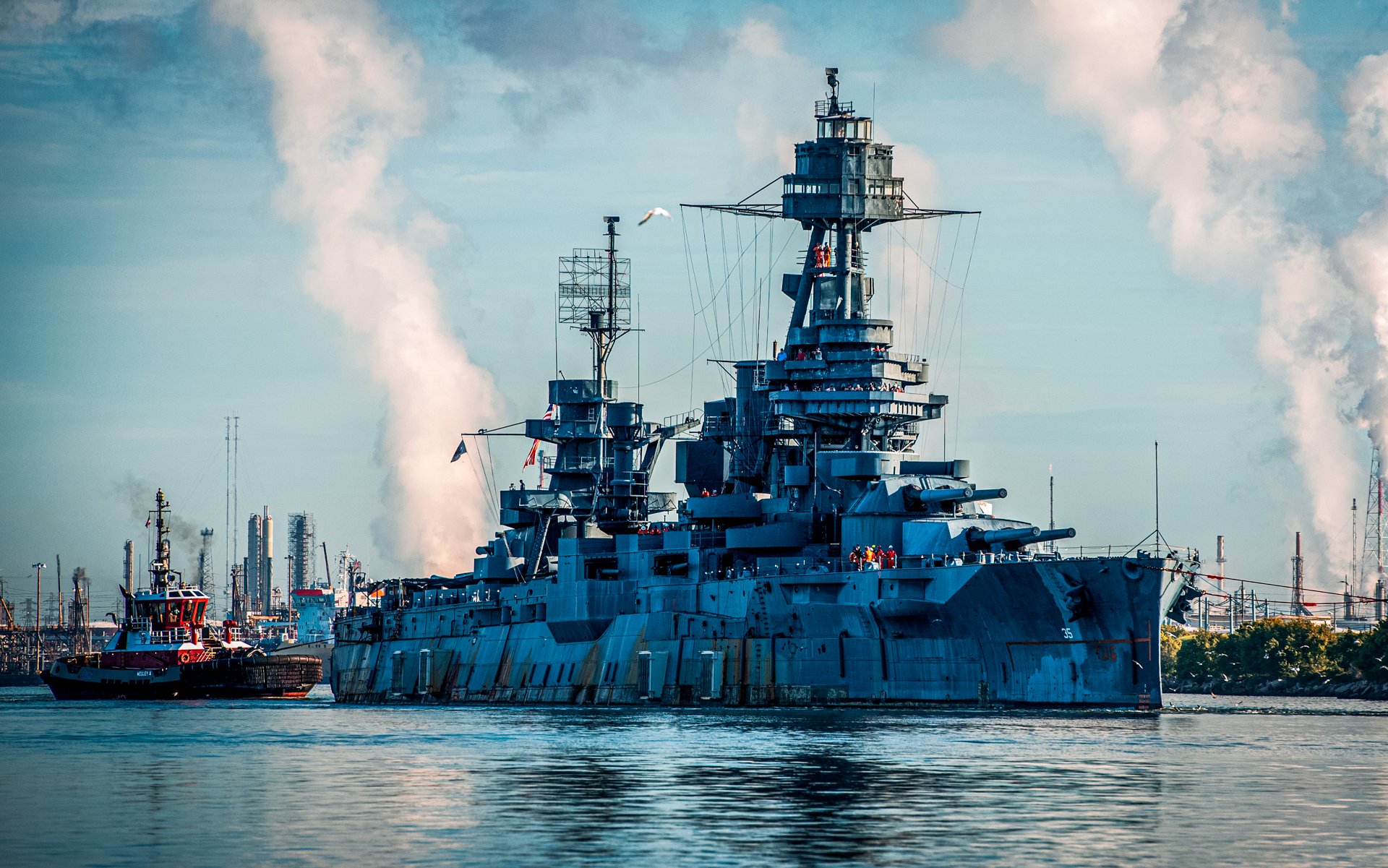
Pilot boat crews tow the battleship USS Texas down the Houston Ship Channel near Baytown, Texas, Aug. 31, 2022. The USS Texas has been moved from the San Jacinto Battleground State Historic Site in La Porte, Texas, to a dry dock in Galveston, Texas, for extensive hull repairs. US Coast Guard photo by Petty Officer 1st Class Corinne Zilnicki.
It’s a true icon of American history.
The USS Texas has survived two World Wars, German hits, and serious leaks over the last century, including being intentionally flooded. It propelled Walter Cronkite into a career as a war correspondent, appeared in an Oscar-nominated blockbuster, and transported thousands of troops home as part of Operation Magic Carpet. Plus, the battleship pioneered aviation, radar, and gunnery innovation that is still employed today.
The USS Texas, often dubbed “Mighty T,” has achieved an incredible legacy — and it’s still kicking.
The World’s Greatest Weapon
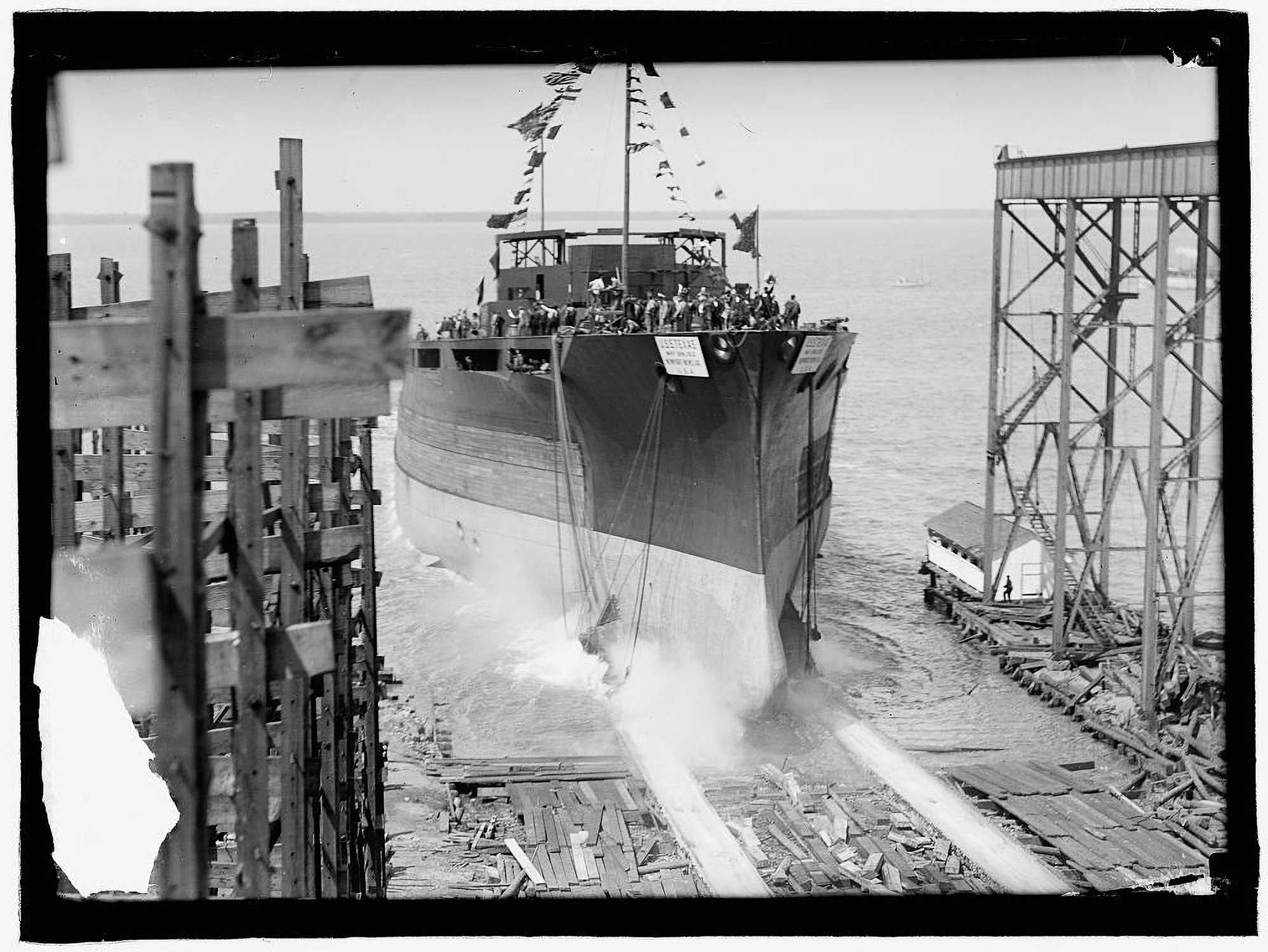
The USS Texas was launched on May 18, 1912, from Newport News. Photo by Harris & Ewing via Library of Congress.
In 1910, the United States Congress signed off on building a second Navy ship named after the Lone Star State. Newport News Shipbuilding won the contract with a $5.83 million bid.
Construction of the USS Texas began in 1911, and sponsored by Claudia Lyon — the daughter of Col. Cecil Lyon, Republican National Committeeman from Texas — it launched on May 18, 1912.
When it was commissioned in March 1914 with Capt. Albert W. Grant at the helm, the USS Texas was the most powerful and advanced weapon in existence. The New York–class battleship’s main battery featured ten 14-inch 45-caliber guns capable of firing 1,400-pound armor-piercing shells up to 13 miles; the secondary battery was outfitted with 5-inch 51-caliber guns.

The USS Texas, shown here off the coast of New York City in 1919, was considered the most powerful weapon on earth during its commission. Naval History and Heritage Command photo.
Its torpedo rooms housed 12 torpedoes as well as 12 naval defense mines. At the time, the USS Texas was a military marvel.
It became the first US battleship to mount anti-aircraft guns and to control gunfire with rangefinders and directors in 1916. Three years later, the USS Texas became the first to launch an aircraft — a Sopwith Camel piloted by Lt. Comm. Edward O. McDonnell at Guantanamo Bay.
In April 1914, it first served in a support role in waters off the coast of Mexico following the Tampico Incident.
World War I & Interwar Period

Crewmen of the USS Texas pose for a picture on top of one of the turrets' main battery guns, 1918. Despite some missions, the USS Texas did not see significant combat action throughout World War I. United States Defense Visual Information Center photo.
As the US entered World War I, the USS Texas joined the Grand Fleet and provided reinforcement for the British Squadron. A gun crew from the USS Texas was loaned to the SS Magnolia and opened fire on a German U-Boat, marking the first American shots of the war.
During World War I, the USS Texas also served in the Battleship Force of the Atlantic Fleet and took part in American maneuvers in the North Sea against the German High Seas Fleet.
But despite several minor missions, the USS Texas itself did not see significant combat action during World War I. It returned to the US in December 1918 and resumed duties with the Atlantic Fleet.
The USS Texas was reassigned to the Pacific Fleet in 1919 before being designated BB-35 the following year. It received major modifications beginning in 1925, including new oil-fired boilers, robust tripod masts, a single stack that replaced the two original stacks, combat system improvements, and the addition of torpedo blisters.
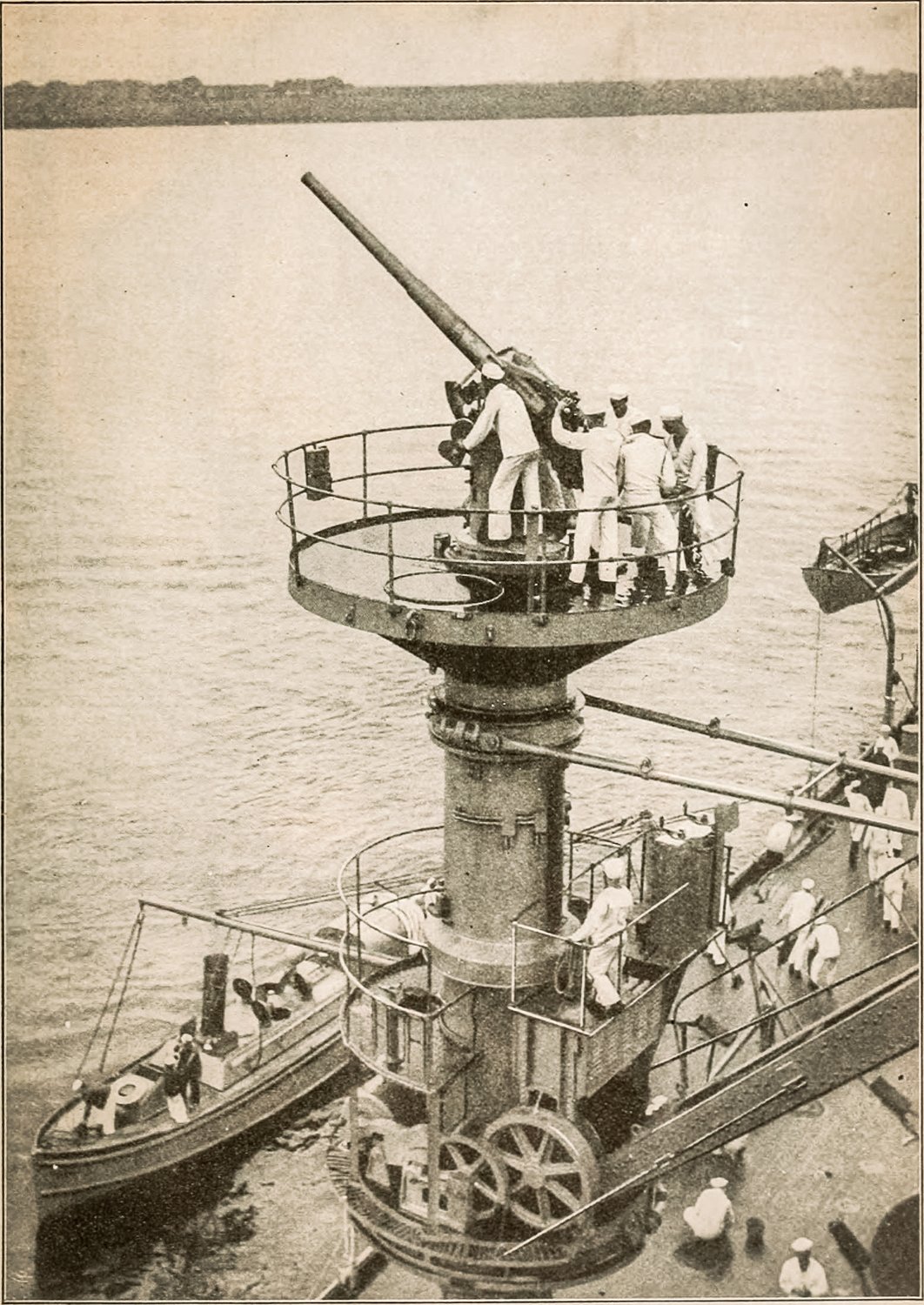
A 3-inch 50-caliber antiaircraft gun on a platform atop a boat crane on the USS Texas installed in 1916 is said to be the first AA gun installation on a US battleship. Internet Archive Book Images photo via Wikimedia Commons.
Following its makeover, the USS Texas rotated between the Atlantic and Pacific before its home base was moved to California in 1931. It was the fleet and division flagship during exercises for the next six years.
Then in 1937, the USS Texas was again reassigned to the East Coast, becoming the flagship of the new Atlantic Squadron shortly after. Throughout these interwar years, the USS Texas primarily focused on training missions, Naval Reserve drills, and Fleet Marine Force training.
The ship received the first radar developed by a commercial company for testing in 1938, then became one of only 14 battleships to get RCA CXAM-1 radar in 1941.
World War II
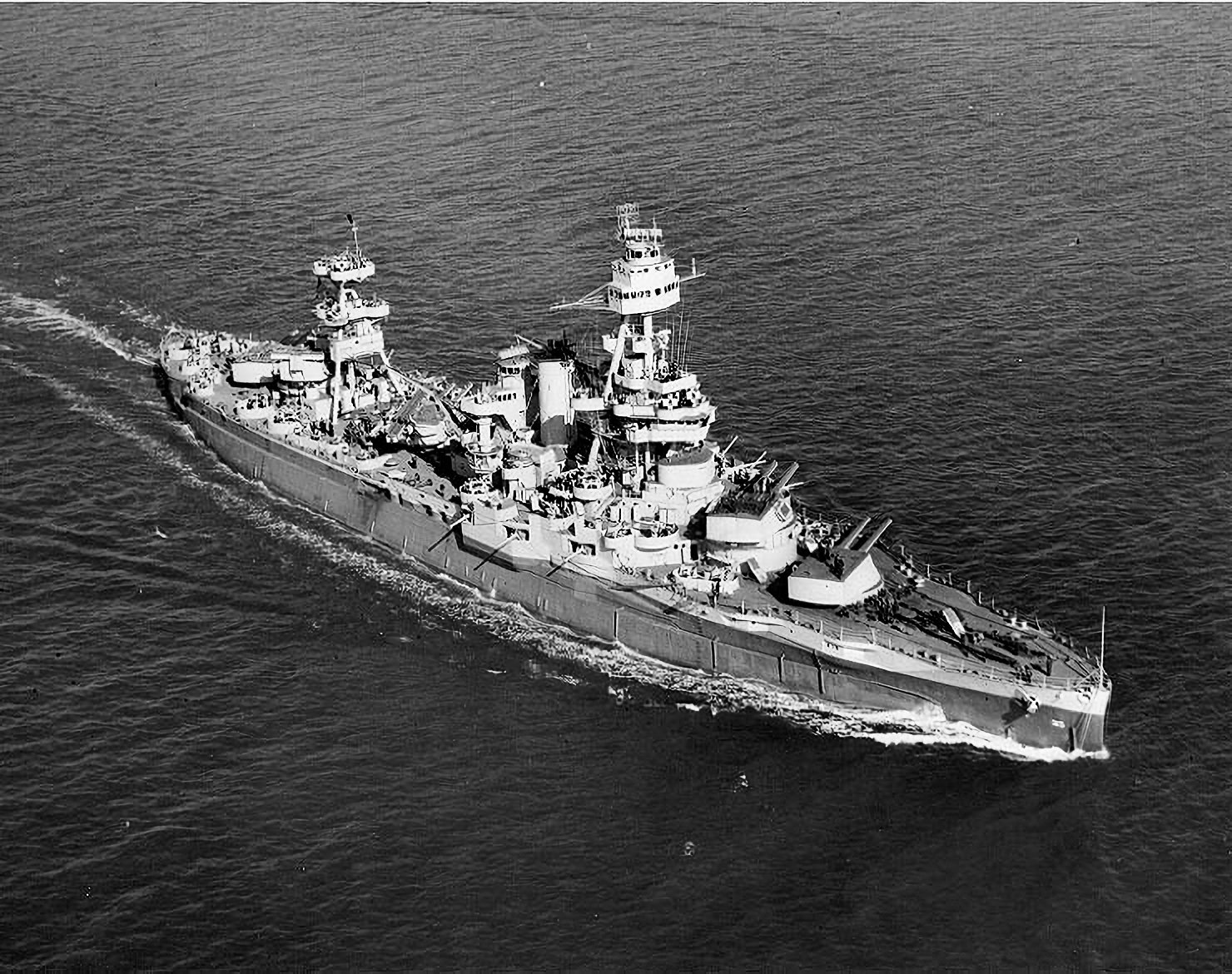
The USS Texas was aging by the time World War II began, but it received radar, fire-control, and communications equipment upgrades as well as new anti-aircraft batteries in the early 1940s that kept it up-to-date. US Navy photo.
Although the USS Texas was an older ship by the time World War II began, it received radar, fire-control, and communications equipment upgrades as well as new anti-aircraft batteries in the early 1940s that kept it up-to-date.
The invasion of North Africa in October 1942 as part of Operation Torch marked the USS Texas’ first major combat operation. After a surprise landing, the US Army directed the ship to fire on a Vichy French Army ammunition dump. The USS Texas received another firing mission before the cease fire on Nov. 11, and several crew members headed inshore to help salvage ships that went down in the harbor.
The USS Texas, along with the British cruiser Glasgow, arrived in Normandy on June 6, 1944, and entered the Omaha Beach western fire support lane as part of the 702-ship US-British flotilla.
It fired 255 shells in 34 minutes, the ship’s longest sustained firing period in World War II. The ship then targeted farther inland and continued hammering German positions for the next two days.
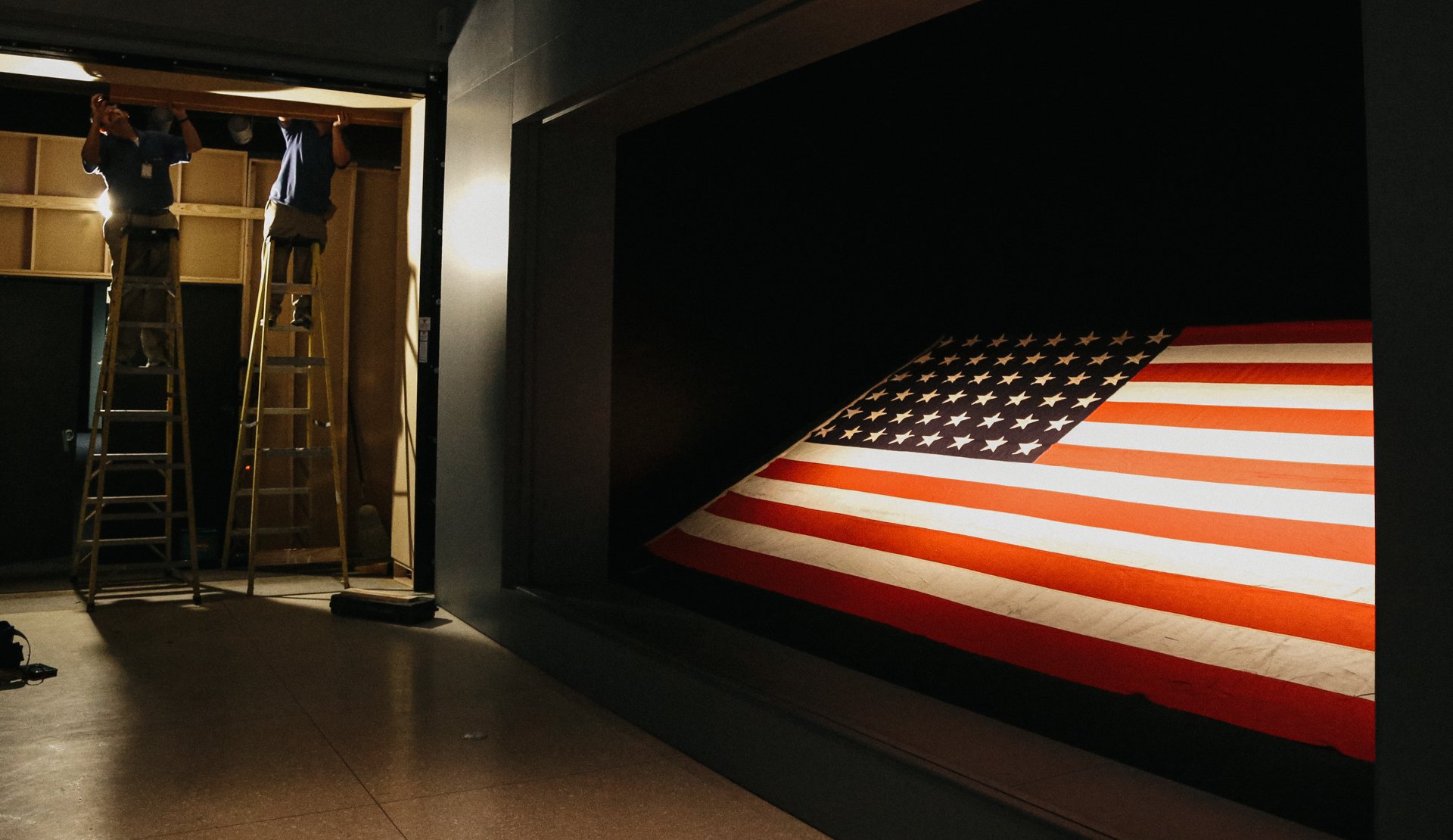
In this photo taken Wednesday, May 21, 2014, workers at the Houston Museum of Natural Science work on an exhibit spotlighting the flag from the USS Texas in Houston. The 17-by-9 foot, 48-star flag flew over the battleship on D-Day, June 6, 1944, off the beaches at Normandy. AP photo by Pat Sullivan.
After a trip back to England, the USS Texas returned on June 15, 1944, to support the move inland. But because the Allied Forces had already advanced beyond its range, the battleship’s guns couldn’t aim high enough to reach their intended target. The USS Texas continued to receive requests for fire missions, so the crew decided on an off-the-wall strategy to stay in the game.
Since they couldn’t raise the portside guns any higher, they lowered the starboard side. To do so, the crew flooded the ship’s torpedo blister, dropping the ship slightly deeper into the water, gaining the additional 2 degrees needed to create the perfect firing angle. And it worked.
After the action exceeded the ship’s range again, the USS Texas left Normandy and headed back to England on June 18, 1944. But the crew’s D-Day heroics helped the Allied Forces advance for an ultimately successful invasion.
A week later, the USS Texas and USS Arkansas were ordered to engage the Battery Hamburg as part of the bombardment of Cherbourg. After three German shells straddled the ship, it returned fire and an exchange continued that led to an explosion onboard that caused damage to the USS Texas and 11 casualties, including one fatality. Despite the hit, the ship continued to engage and shortly after managed a direct hit that destroyed a heavily reinforced gun emplacement.
Over the course of three hours, the USS Texas faced 65 near-misses but continued on task until it was ordered to retire. An unexploded shell that entered the ship was disarmed and is now on display in the USS Texas.
The USS Texas moved onto the Pacific later that year to support the landing at Iwo Jima, firing 923 rounds from the main battery between Feb. 18 and March 7, 1945. A few weeks later, the ship participated in the invasion of Okinawa. It bombarded the coast for six weeks, then left unscathed on May 14.
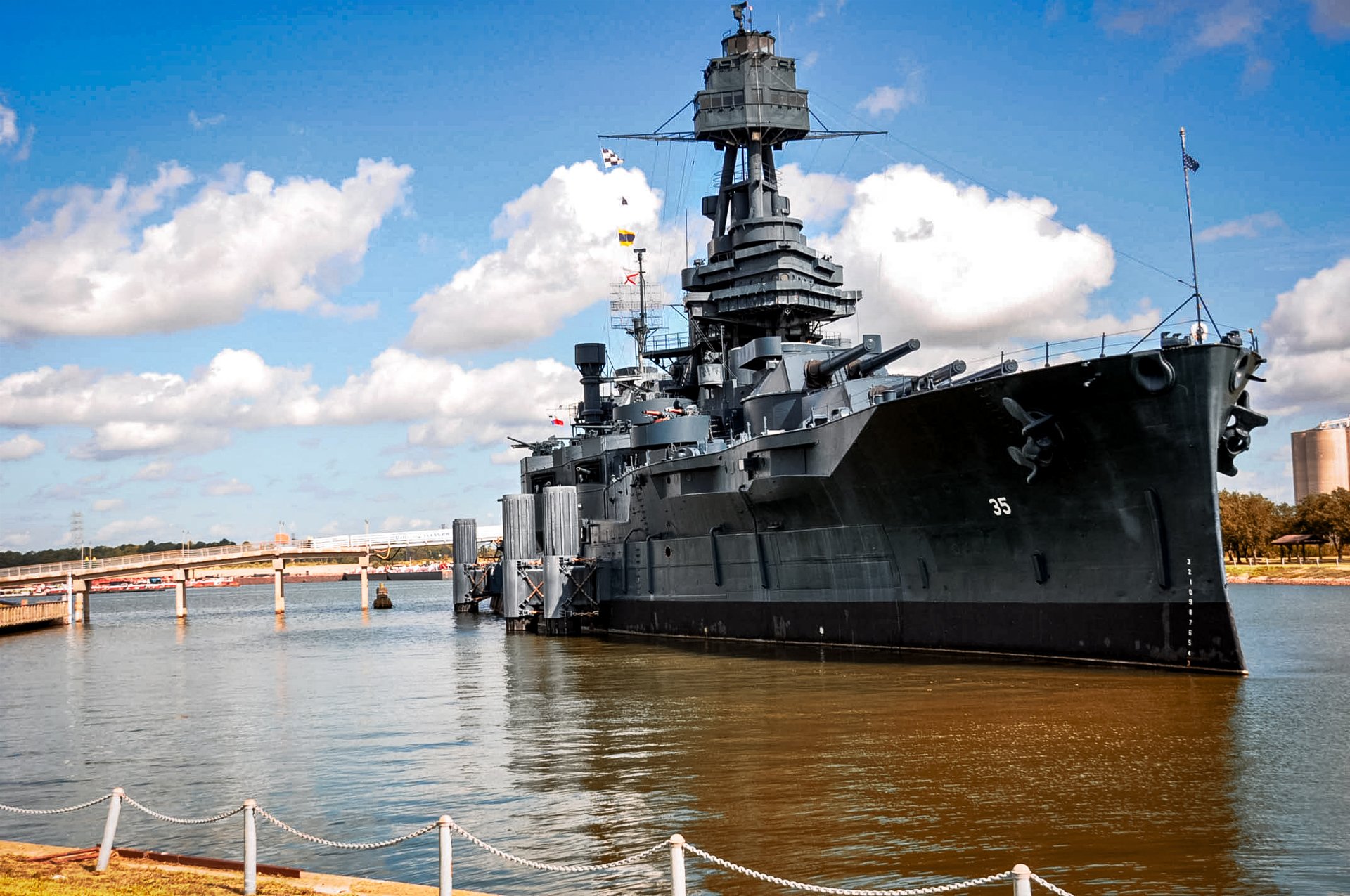
The museum battleship USS Texas is being restored to its 1945 condition. The former USS Texas (BB 35) was commissioned on March 12, 1914, and decommissioned on April 21, 1948. The battleship saw action in World War I and World War II. Compartments of this museum ship have been featured in several Hollywood movies, including Pearl Harbor and Flags of Our Fathers. US Navy photo.
Nearing the end of World War II, the USS Texas transported prisoners of war from the Philippines to Pearl Harbor and brought almost 5,000 troops home to California on “Magic Carpet” voyages.
The USS Texas was decommissioned in 1948 after earning five battle stars for its service during World War II. And while it may not have sunk any ships during its commission, it played an important role in world events that have shaped history.
Battleship Texas
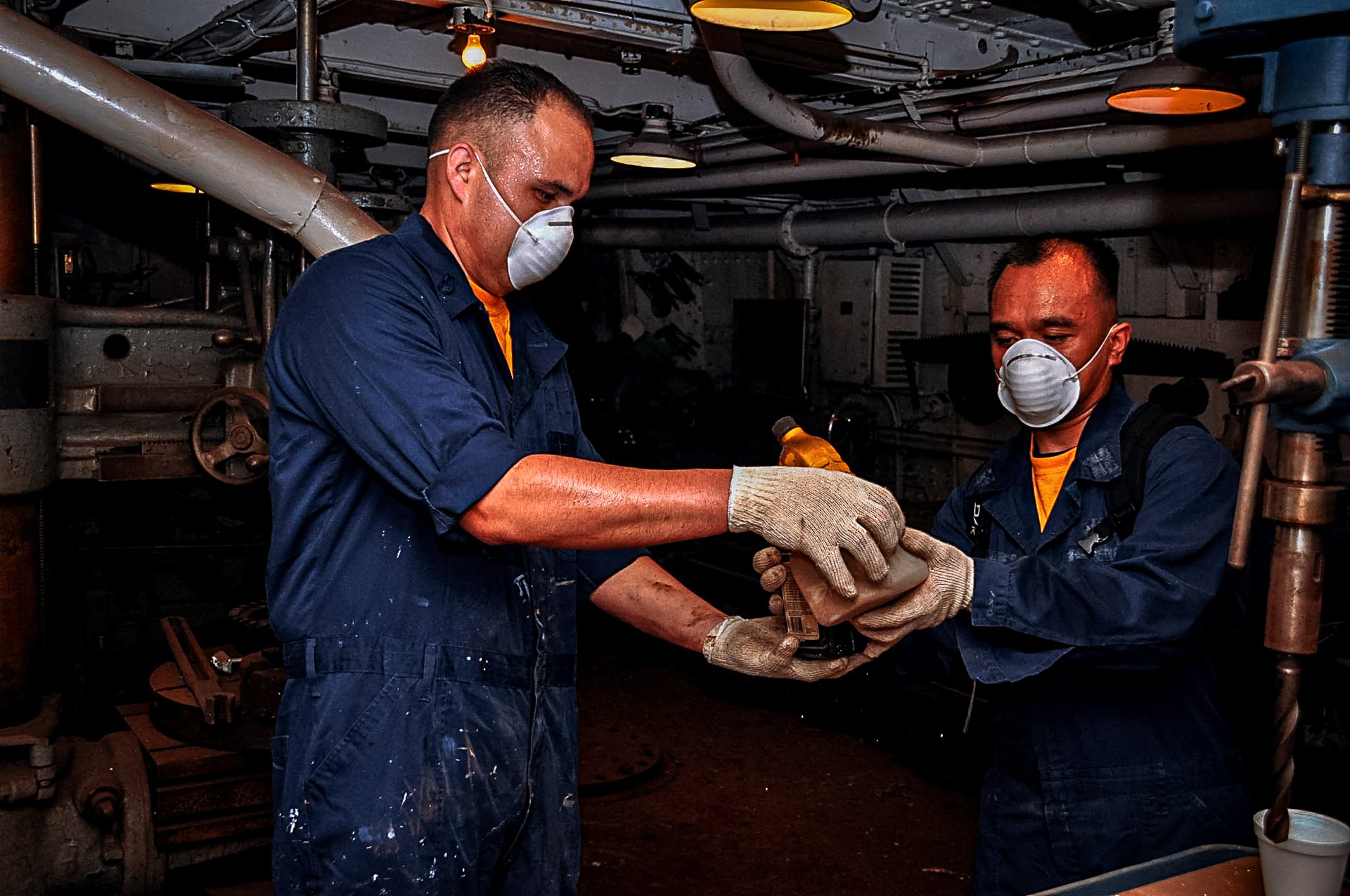
Navy career counselors Chief Petty Officer (Sel.) Juval Velasquez and Chief Petty Officer (Sel.) Giovanni Salvador clean the machine shop aboard the museum battleship USS Texas as part of a Navy Recruiting District, Houston, chief indoctrination community relations project. US Navy photo.
Although it was originally slated as a bombing target following decommission, citizens of the ship’s namesake state successfully launched a campaign to make the USS Texas the country’s first permanent memorial battleship.
The US Navy towed it to Texas and transferred control to the state of Texas during a ceremony at San Jacinto Battleground on April 21, 1948.
The Battleship Texas Commission cared for the ship for 35 years, during which time it was named a National Historic Engineering Landmark and a National Historic Landmark — the first-ever battleship to receive this designation. In 1983, Texas Parks & Wildlife took control of the USS Texas.
Since 2020, the Battleship Texas Foundation has managed day-to-day maintenance and operations. The USS Texas was moved to a dry dock in Galveston in August 2022 for a $35 million repair project that is currently in progress. Visitors can still tour the museum ship while the updates are underway.
Read Next: Portrait of a Ship: USS Abraham Lincoln

Previously a hunting editor for Outdoor Sportsman Group, Emily Kantner is a freelance writer, editor, and marketing consultant. Her work has appeared in Game & Fish, Petersen’s Hunting, Wide Open Spaces, Wildfowl, and MeatEater. When she’s not working, you can find her chasing wild things with a bow near her hometown of Hershey, Pennsylvania.
BRCC and Bad Moon Print Press team up for an exclusive, limited-edition T-shirt design!
BRCC partners with Team Room Design for an exclusive T-shirt release!
Thirty Seconds Out has partnered with BRCC for an exclusive shirt design invoking the God of Winter.
Lucas O'Hara of Grizzly Forge has teamed up with BRCC for a badass, exclusive Shirt Club T-shirt design featuring his most popular knife and tiomahawk.
Coffee or Die sits down with one of the graphic designers behind Black Rifle Coffee's signature look and vibe.
Biden will award the Medal of Honor to a Vietnam War Army helicopter pilot who risked his life to save a reconnaissance team from almost certain death.
Ever wonder how much Jack Mandaville would f*ck sh*t up if he went back in time? The American Revolution didn't even see him coming.
A nearly 200-year-old West Point time capsule that at first appeared to yield little more than dust contains hidden treasure, the US Military Academy said.












